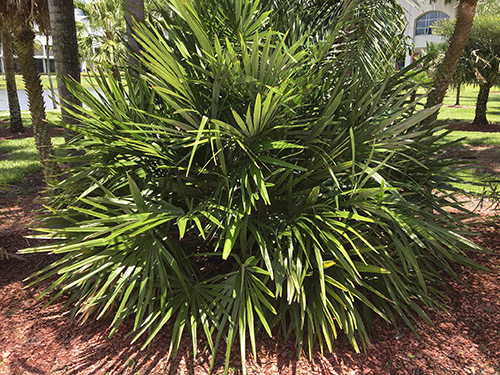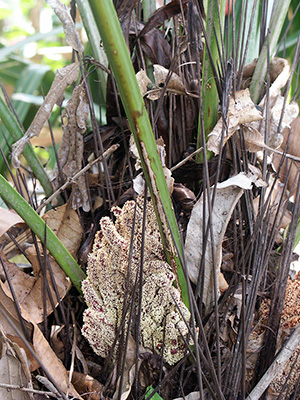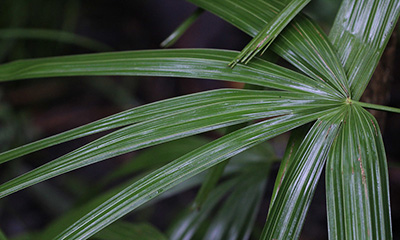Needle Palm
Needle palm is a native plant that can work well in home landscapes throughout Florida.

Its lustrous, evergreen leaves make it a great accent plant and help it add good textural interest beneath new or established trees. Native to the southeastern United States, needle palm is found in floodplains and swampy areas in South Carolina, Georgia, Florida, Alabama, and Mississippi.
This Florida-Friendly palm works well as an accent plant or security hedge, sporting sharp, black needles on its trunk.
Characteristics
Needle palm (Rhapidophyllum hystrix) is a slow-growing, shrubby perennial that will eventually grow into a clump that is eight feet tall and eight feet wide. Its common name comes from the sharp, black needles found along its trunk.
It has a short, stocky, reddish-brown trunk with large palmate leaves divided into 5 to 12 narrow, stiff segments arranged like a fan. The underside of the leaves is silvery-gray while the topside is dark green. The sharp black spines that grow along its trunk are 6 to 10 inches. Its dense foliage serves as wildlife shelter and habitat, attracting various species to its cover.

In the spring and summer, yellowish-brown three-petaled flowers bloom, unassuming and hidden underneath the foliage. In the fall after the blooming period, small, fuzzy reddish-brown fruits develop on the female plants. These unpleasant-smelling fruits grow close to the stem tangled amongst the needles. Deer generally avoid eating needle palm, but some other mammals such as bears will consume the fruits.
The palm is especially prized among cold-climate gardeners who want a tropical look, since it can tolerate temperatures several degrees below 0°F. Unprotected specimens are known to grow as far north as Washington D.C. and New York City.
Planting and Care
Needle palm is endangered in the wild and protected, so be sure to only purchase cultivated palms from reputable nurseries. Appreciated for its cold hardiness, needle palm’s additional ability to thrive in heat and drought make it a versatile plant. The palm can be grown in zones 6b to 10b; it prefers partial shade, with rich, moist well-drained soil, but can be grown in full sun. It will need regular waterings at first but can withstand drought conditions once established. Needle palm spreads slowly by suckers, which are shoots that grow from the base or roots of the plant. Propagating the plant by dividing these suckers is possible but difficult and hazardous due to the sharp needles. It can also be propagated by seeds but has a lengthy germination (6 to 12 months).
Needle palm works well in the understory to add filler foliage around trees in the landscape. It can be planted as a security hedge, or a foundational plant to be featured around the side of the home. Needle palm can be both aesthetic and practical, providing a vertical transition from smaller ornamental plants to taller shrubs and trees. The palm grows well in coastal, riparian (close to a river or stream), or woodland areas. Be cautious about where you choose to plant needle palm; it’s a good idea to place it away from play areas or walkways to avoid any incidents with its spines.

While needle palm is not something you want to cozy up next to, it’s a classic and flourishing native plant that is a welcome feature of our natural landscape. Its versatility and tolerance for the elements make it an appealing Florida-Friendly option for any yard.
For more information on needle palm, contact your county Extension office.
